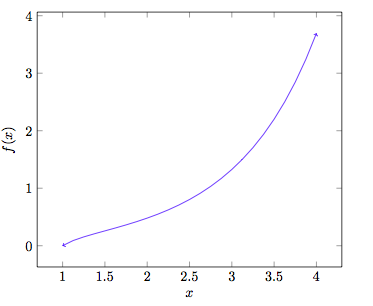Calculus problem #2152

If y = ( ln x ) x , what is the derivative of y at x = e ?
The answer is 1.
This section requires Javascript.
You are seeing this because something didn't load right. We suggest you, (a) try
refreshing the page, (b) enabling javascript if it is disabled on your browser and,
finally, (c)
loading the
non-javascript version of this page
. We're sorry about the hassle.
7 solutions
I've made a mistake when putting x = e initially, so I had y = lne^{e} = const then y' = 0
At x = e , y = ( ln e ) e = 1
y = ( ln x ) x
ln y = x × ln ( ln x )
Differentiating with respect to x,
y 1 × d x d y = ln ( ln x ) + ln x 1
At x = e and y = 1,
1 × d x d y = 0 + 1 = 1
taking log both sides and then differentiating so that dy/dx=y.{ln(lnx)+1/lnx}
y=(ln x)^x taking log base 'e' on both the sides we arrive at, =1/y* dy/dx=ln( ln x) + x (1/ln(x) ) * (1/x) {Using chain rule} =1 dy/dx= 0+1 {at x=e} =1
y = ( ln x ) x
ln y = x . ln ( ln x ) )
y y ′ = 1 . ln ( l n x ) + ln x 1 . x 1 . x
y ′ = y . ( ln ( ln x ) + ln x 1 ) .
y ′ = ( ln x ) x . ( ln ( ln x ) + ln x 1 )
When x = e , then
y ′ ( e ) = ( ln e ) e . ( ln ( ln e ) + ln e 1 )
y ′ ( e ) = 1 e . ( ln 1 + 1 1 )
y ′ ( e ) = 1 . ( 0 + 1 )
y ′ ( e ) = 1
would you tell me please ,Why do we put ( Ln e) =1 ???
Log in to reply
ln x is actually lo g e x and lo g x x = 1 for any x ∈ R
So, if x = e , then ln e = lo g e e = 1
Actually, all you have to do is to find the derivative of { (\ln { x) } }^{ x } and then (using power rule and derivative of natural log) you get \frac { 1 }{ x } x, which is just 1 (the answer!)
Sorry, formatting didn't work properly...
y=({ \ln { x } ) }^{ x }\quad \ y=({ \ln { e } })^{ e }\quad where\quad x=e\ y={ 1 }^{ e }\ y=1
y = ( ln x ) x y = ( ln e ) e w h e r e x = e y = 1 e y = 1
Log in to reply
Totally wrong lol. They want the value of y' NOT y. It happens that it's the same value here , but it will not happen everytime
y = ( ln x ) x = > ln y = x ln ( ln x ) = > y 1 d x d y = x × ln x 1 × x 1 + ln ( ln x ) = > d x d y = y × ( x × ln x 1 × x 1 + ln ( ln x ) ) = > d x d y = ( ln x ) x × ( x × ln x 1 × x 1 + ln ( ln x ) )
Putting x = e derivative is: ( ln e ) e × ( e × ln e 1 × e 1 + ln ( ln e ) ) = 1